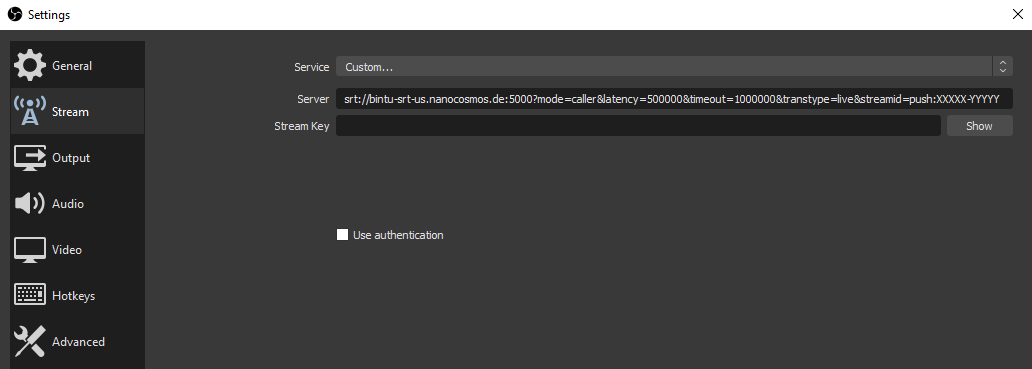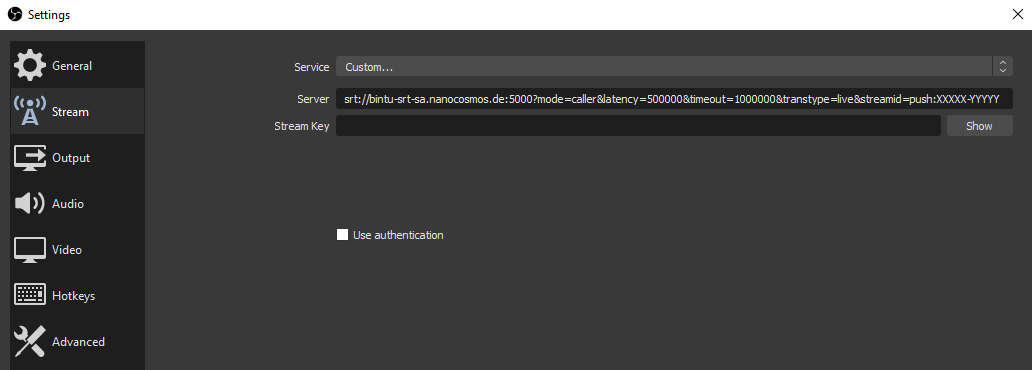nanoStream Cloud SRT Ingest Guide
Introduction
Thank you for your interest in SRT (Secure Reliable Transport) streaming on nanoStream cloud. We are glad that you can start using this new feature.
Feedback
We welcome any feedback that can help us improve the service. Send an email to support@nanocosmos.de with subject SRT feedback program and do share with us the following information:
- Encoding or streaming software being used and hardware equipment setup.
- Video and audio encoding, or streaming parameters being used. For example: format, resolution, bit-rate, and so on.
- Full test results with description of expected outcomes and issues encountered.
- All issues reported must contain a time frame in UTC and relevant stream names.
SRT Setup Guide
The SRT setup will require creating a new stream or making use of an existing stream in your organization account for publishing and viewing. In this workflow, SRT streaming protocol will be used for ingest while playing back with H5Live player or RTMP protocol. SRT playback is not supported at the moment.
Ingest
Supported Formats and Codecs
| Stream format | MPEG-TS |
| Track count | Single channel of video and/or single channel of audio |
| Video codec | H.264 |
| Audio codec | AAC |
Server Domains and Port
| Global domain (preferred) | bintu-srt.nanocosmos.de |
|---|---|
| Asia domain | bintu-srt-as.nanocosmos.de |
| Europe domain | bintu-srt-eu.nanocosmos.de |
| North America domain | bintu-srt-us.nanocosmos.de |
| South America domain | bintu-srt-sa.nanocosmos.de |
| Port number | 5000 |
SRT Stream Id
SRT stream id format definition: prefix:streamname[:postfix]
- prefix:
pushfor ingest or publish action - streamname: existing Bintu stream name in the form
XXXXX-YYYYY - suffix:
recordto enable VOD recording of a live stream (optional)
Stream Id limitations
- The SRT protocol specification limits the Stream Id length to 512 characters.
- Allowed character set in SRT Stream Ids:
a-z,A-Z,0-9,?,&,=,-,_,,plus delimiter:. - Colon delimiter
:is permited on the stream id, not on stream name nor stream name parameters. - Percent sign
%is only allowed in the context of URL encoding.
Stream Id examples
Replace XXXXX-YYYYY with an existing Bintu stream name.
Basic push:
push:XXXXX-YYYYY
Push with vod recording:
push:XXXXX-YYYYY:record
Push with stream name parameters:
push:XXXXX-YYYYY?param1=one¶m2=two
Push with stream name parameters and VOD recording:
push:XXXXX-YYYYY?param1=one¶m2=two:record
Note: Some streaming applications where the SRT stream id needs to be configured as part of a URL, for example OBS Studio, may require the stream name parameters to use URL encoding. The URL encoding can be applied to the entire Stream Id or stream name parameters only. The URL encoded parts will be decoded accordingly on the server side.
See the following examples:
Push with URL encoded stream id:
push%3AXXXXX-YYYYY%3Fparam1%3Done%26param2%3Dtwo
Push with URL encoded stream name parameters:
push:XXXXX-YYYYY%3Fparam1%3Done%26param2%3Dtwo
Push with URL encoded stream name parameters and VOD recording:
push:XXXXX-YYYYY%3Fparam1%3Done%26param2%3Dtwo:record
Ingest Parameters
| SRT mode | caller |
| SRT transmission type | live |
| SRT latency | Default is 500ms. Higher values can be used to maintain more buffer and will help to reduce packet drop in lossy transmission situations. |
| SRT timeout | Recommended is 1 second. Higher values can solve connect issues in case of longer routing distances or high round trip times (RTT). |
| SRT stream id | See Above. |
Example of Setup using OBS Studio
OBS Studio is able to support SRT streaming in versions 25.0 or newer and has the flexibility of fine tuning capabilities. You can refer more here: SRT Protocol Streaming Guide
Note:
OBS expects timeout and latency values in microseconds, that is, seconds ⨉ 1000000.
Ingest Address
Global Ingest Domain (Recommended)
Setup server with:
srt://bintu-srt.nanocosmos.de:5000?mode=caller&latency=500000&timeout=1000000&transtype=live&streamid=push:XXXXX-YYYYY

For Europe Domain
Setup server with:
srt://bintu-srt-eu.nanocosmos.de:5000?mode=caller&latency=500000&timeout=1000000&transtype=live&streamid=push:XXXXX-YYYYY

For North America Domain
Setup server with:
srt://bintu-srt-us.nanocosmos.de:5000?mode=caller&latency=500000&timeout=1000000&transtype=live&streamid=push:XXXXX-YYYYY

For South America Domain
Setup server with:
srt://bintu-srt-sa.nanocosmos.de:5000?mode=caller&latency=500000&timeout=1000000&transtype=live&streamid=push:XXXXX-YYYYY

Whereby XXXXX-YYYYY is an existing Bintu stream name in your organization account and latency, andtimeout values provided in microseconds.
Stream Transcoding and ABR
If your organization account has transcoding feature enabled you may set up ABR with SRT. Just use the pass-through stream name for SRT ingest.
Playback
SRT playback is not supported at the moment. Playback is possible using the H5live Player or through RTMP protocol.
Using H5Live Player
For a single bit-rate stream, the ingested stream can be played out with the following playback URL:
https://demo.nanocosmos.de/nanoplayer/release/nanoplayer.html?entry.rtmp.streamname=XXXXX-YYYYY
Whereby XXXXX-YYYYY is the Bintu stream name previously set up for SRT ingest.
For ABR playback, you can setup a stream group on the latest dashboard v3. Find more information following the video guide in the link:
How To Setup Streamgroups Through V3 Dashboard
For the corresponding stream group setup, find the player configuration here:
If you are on a secure Bintu organization account, you will find information on playback with secure parameters here:
Using RTMP
Following, an example using RTMP protocol playback with ffplay from the ffmpeg project on the command line:
ffplay rtmp://bintu-play.nanocosmos.de/play/XXXXX-YYYYY
Whereby XXXXX-YYYYY is the Bintu stream name that was configured in the SRT ingest.
